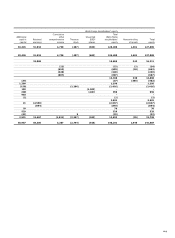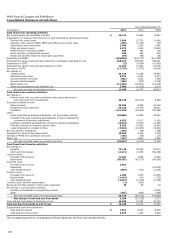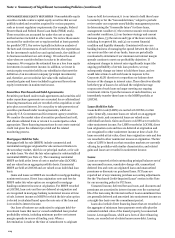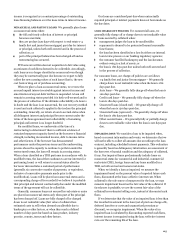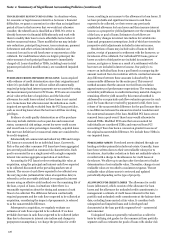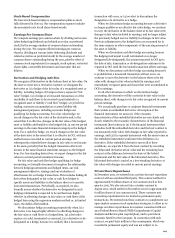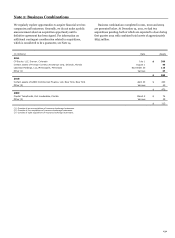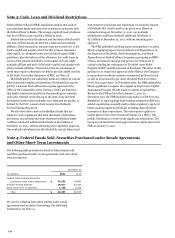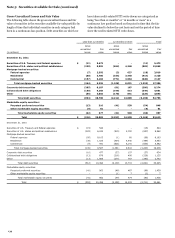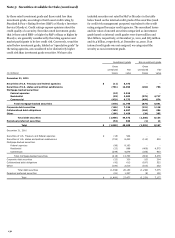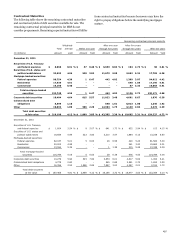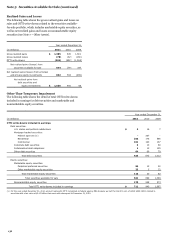Wells Fargo 2011 Annual Report Download - page 131
Download and view the complete annual report
Please find page 131 of the 2011 Wells Fargo annual report below. You can navigate through the pages in the report by either clicking on the pages listed below, or by using the keyword search tool below to find specific information within the annual report.Stock-Based Compensation
We have stock-based employee compensation plans as more
fully discussed in Note 19. Our compensation expense includes
the associated costs for all share-based awards.
Earnings Per Common Share
We compute earnings per common share by dividing net income
(after deducting dividends and related accretion on preferred
stock) by the average number of common shares outstanding
during the year. We compute diluted earnings per common
share by dividing net income (after deducting dividends and
related accretion on preferred stock) by the average number of
common shares outstanding during the year, plus the effect of
common stock equivalents (for example, stock options, restricted
share rights, convertible debentures and warrants) that are
dilutive.
Derivatives and Hedging Activities
We recognize all derivatives in the balance sheet at fair value. On
the date we enter into a derivative contract, we designate the
derivative as (1) a hedge of the fair value of a recognized asset or
liability, including hedges of foreign currency exposure (“fair
value” hedge), (2) a hedge of a forecasted transaction or of the
variability of cash flows to be received or paid related to a
recognized asset or liability (“cash flow” hedge), or (3) held for
trading, customer accommodation or asset/liability risk
management purposes, including economic hedges not
qualifying for hedge accounting. For a fair value hedge, we
record changes in the fair value of the derivative and, to the
extent that it is effective, changes in the fair value of the hedged
asset or liability attributable to the hedged risk, in current period
earnings in the same financial statement category as the hedged
item. For a cash flow hedge, we record changes in the fair value
of the derivative to the extent that it is effective in OCI, with any
ineffectiveness recorded in current period earnings. We
subsequently reclassify these changes in fair value to net income
in the same period(s) that the hedged transaction affects net
income in the same financial statement category as the hedged
item. For free-standing derivatives, we report changes in the fair
values in current period noninterest income.
For fair value and cash flow hedges qualifying for hedge
accounting, we formally document at inception the relationship
between hedging instruments and hedged items, our risk
management objective, strategy and our evaluation of
effectiveness for our hedge transactions. This includes linking all
derivatives designated as fair value or cash flow hedges to
specific assets and liabilities in the balance sheet or to specific
forecasted transactions. Periodically, as required, we also
formally assess whether the derivative we designated in each
hedging relationship is expected to be and has been highly
effective in offsetting changes in fair values or cash flows of the
hedged item using the regression analysis method or, in limited
cases, the dollar offset method.
We discontinue hedge accounting prospectively when (1) a
derivative is no longer highly effective in offsetting changes in
the fair value or cash flows of a hedged item, (2) a derivative
expires or is sold, terminated or exercised, (3) a derivative is de-
designated as a hedge, because it is unlikely that a forecasted
transaction will occur, or (4) we elect to discontinue the
designation of a derivative as a hedge.
When we discontinue hedge accounting because a derivative
no longer qualifies as an effective fair value hedge, we continue
to carry the derivative in the balance sheet at its fair value with
changes in fair value included in earnings, and no longer adjust
the previously hedged asset or liability for changes in fair value.
Previous adjustments to the hedged item are accounted for in
the same manner as other components of the carrying amount of
the asset or liability.
When we discontinue cash flow hedge accounting because
the hedging instrument is sold, terminated or no longer
designated (de-designated), the amount reported in OCI up to
the date of sale, termination or de-designation continues to be
reported in OCI until the forecasted transaction affects earnings.
When we discontinue cash flow hedge accounting because it
is probable that a forecasted transaction will not occur, we
continue to carry the derivative in the balance sheet at its fair
value with changes in fair value included in earnings, and
immediately recognize gains and losses that were accumulated in
OCI in earnings.
In all other situations in which we discontinue hedge
accounting, the derivative will be carried at its fair value in the
balance sheet, with changes in its fair value recognized in current
period earnings.
We occasionally purchase or originate financial instruments
that contain an embedded derivative. At inception of the
financial instrument, we assess (1) if the economic
characteristics of the embedded derivative are not clearly and
closely related to the economic characteristics of the financial
instrument (host contract), (2) if the financial instrument that
embodies both the embedded derivative and the host contract is
not measured at fair value with changes in fair value reported in
earnings, and (3) if a separate instrument with the same terms as
the embedded instrument would meet the definition of a
derivative. If the embedded derivative meets all of these
conditions, we separate it from the host contract by recording
the bifurcated derivative at fair value and the remaining host
contract at the difference between the basis of the hybrid
instrument and the fair value of the bifurcated derivative. The
bifurcated derivative is carried as a free-standing derivative at
fair value with changes recorded in current period earnings.
Private Share Repurchases
In December 2011, we entered into a private forward repurchase
contract with an unrelated third party. This contract settled for
approximately 6 million shares of our common stock in first
quarter 2012. We also entered into a similar contract in
August 2011, which settled in November 2011 for approximately
6 million shares of our common stock. These contracts met
accounting requirements to be treated as permanent equity
transactions. We entered into these contracts to complement our
open-market common stock repurchase strategies, to allow us to
manage our share repurchases in a manner consistent with our
2011 Federal Reserve Board (FRB) Comprehensive Capital
Analysis and Review plan (capital plan), and to provide an
economic benefit to the Company. In connection with each
contract, we paid $150 million to the counterparty, which was
recorded in permanent equity and was not subject to re-
129


